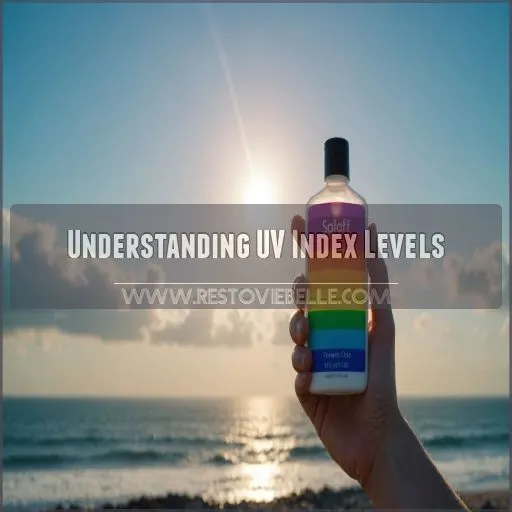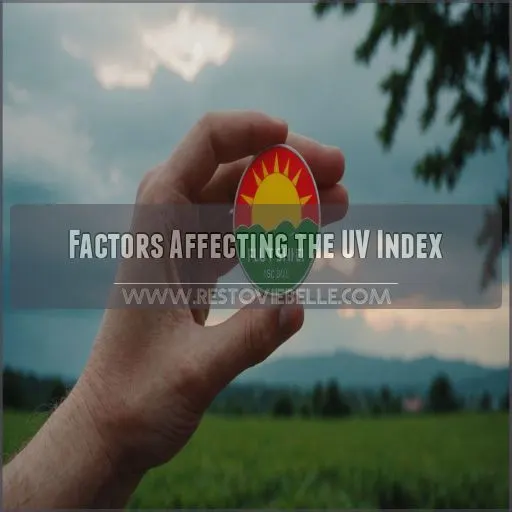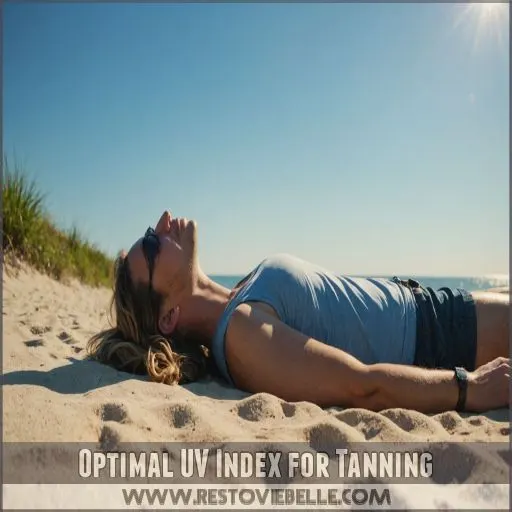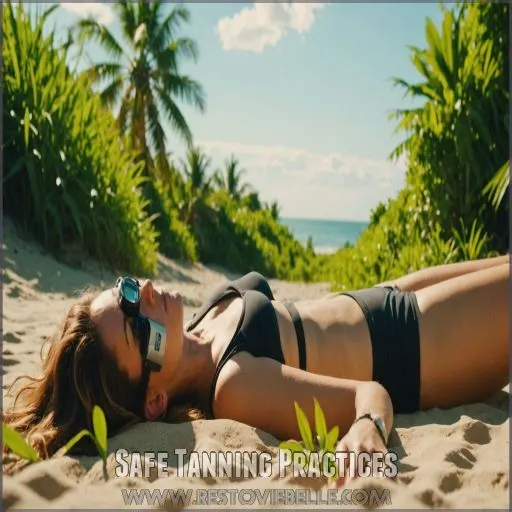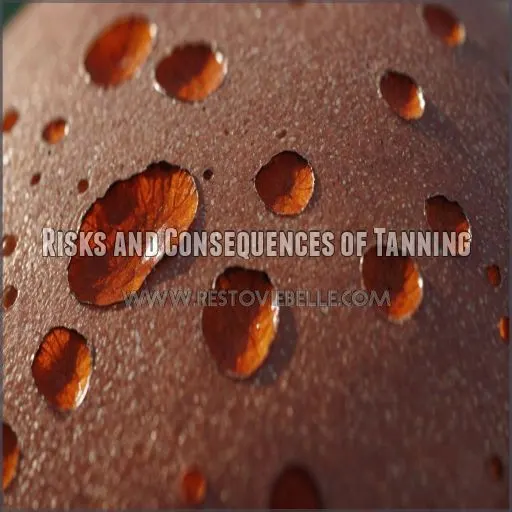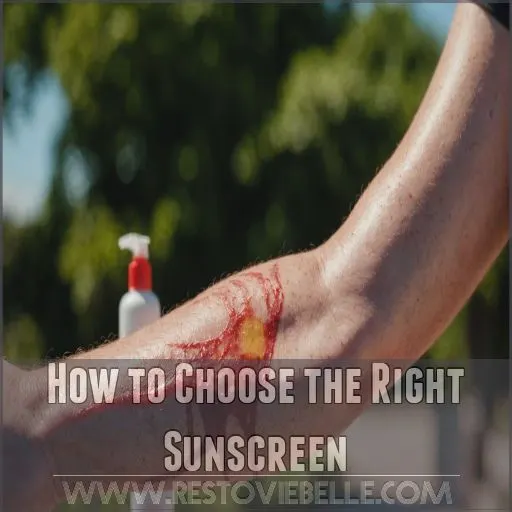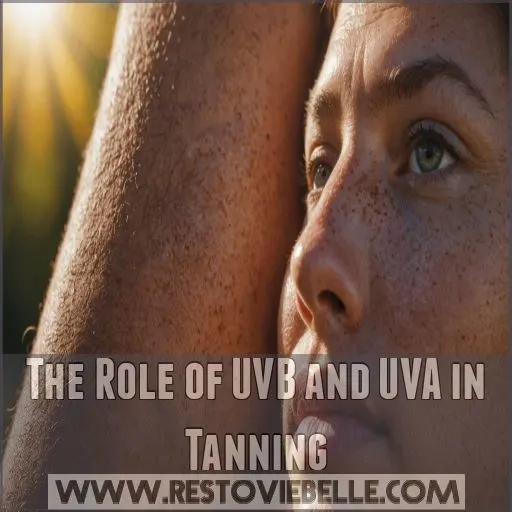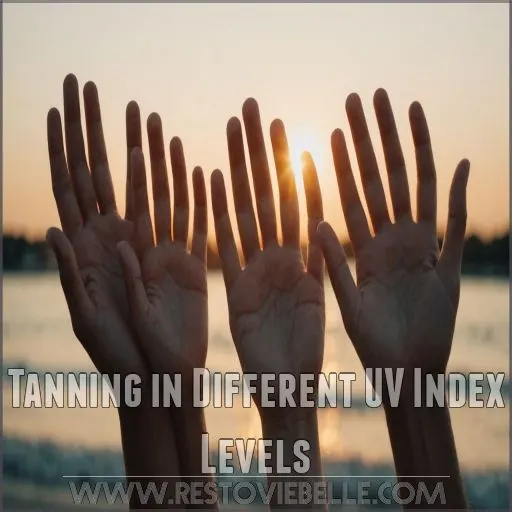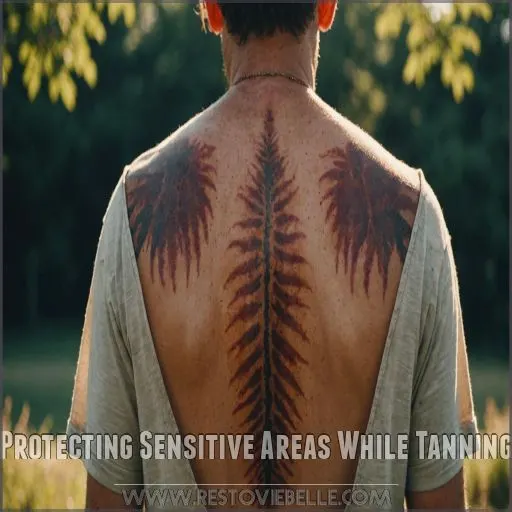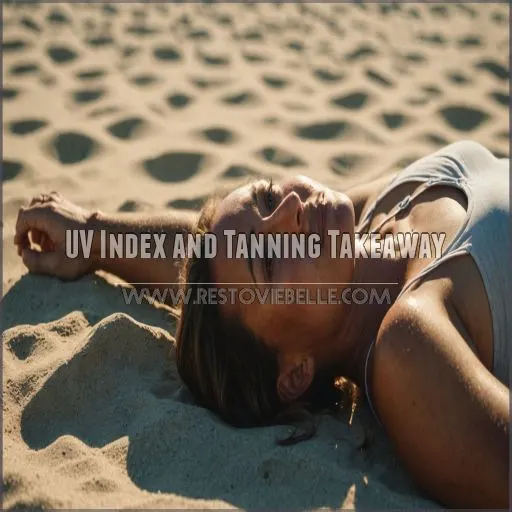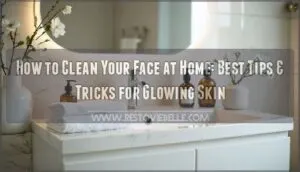This site is supported by our readers. We may earn a commission, at no cost to you, if you purchase through links.
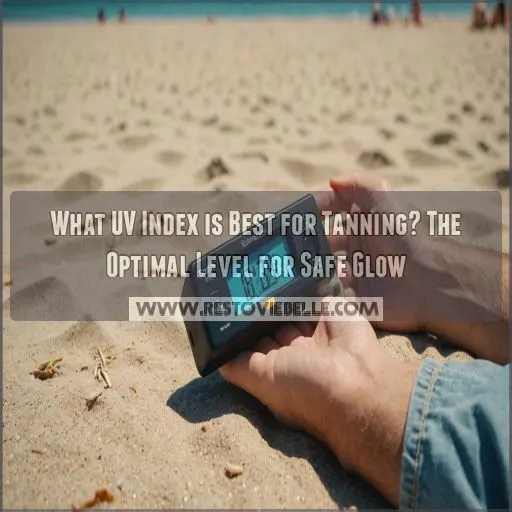
If you’re set on getting a glow, a lower UV index of 3 or below is your best bet for minimizing skin damage, though it still isn’t 100% safe. Any tan is a sign your skin’s crying out for help.
Wear sunscreen SPF 30 or higher, and start with short 10-15 minute sessions. And hey, don’t forget your sunglasses and a wide-brimmed hat—your future self will thank you!
Curious about safe tanning practices? We’ve got some golden tips coming right up.
Table Of Contents
- Key Takeaways
- Understanding UV Index Levels
- Factors Affecting the UV Index
- Optimal UV Index for Tanning
- Safe Tanning Practices
- Risks and Consequences of Tanning
- How to Choose the Right Sunscreen
- The Role of UVB and UVA in Tanning
- Tanning in Different UV Index Levels
- Protecting Sensitive Areas While Tanning
- UV Index and Tanning Takeaway
- Frequently Asked Questions (FAQs)
- Is it safe to tan with a low UV index?
- What is a good UV Index for tanning?
- What is UV index & how does it affect a tan?
- What is a good tanning index?
- Can you tan in UV index 5?
- Is UV-4 good for tanning?
- Can you tan in UV index 3?
- How long in UV 7 to tan?
- How does indoor tanning affect vitamin D levels?
- Are there health regulations for tanning salons?
- Do tanning beds help prevent sunburn?
- What are the risks of overexposure to UV?
- How do tanning bans differ by country?
- Conclusion
Key Takeaways
- When it comes to tanning, aim for a UV index of 3 or lower. It’s like testing the waters before diving in—safer for your skin, but still requiring caution. Remember, any tan hints at some level of skin damage.
- Sunscreen is your trusty sidekick in this sun-drenched adventure. Choose a broad-spectrum SPF 30 or higher, and apply it liberally, as you would frosting on a cake (but reapply every two hours!).
- Protect yourself like a pro! Rock a wide-brimmed hat, UV-blocking sunglasses, and maybe even a stylish long-sleeved shirt. You’ll look chic while keeping those pesky UV rays at bay.
- Slow and steady wins the race. Gradually increase your sun exposure, starting with just 10-15 minutes. Think of it as brewing a perfect cup of tea—not too fast, or you’ll end up with bitter results.
Understanding UV Index Levels
When you’re planning to tan, understanding the UV Index is like checking the ingredients before baking; it’s really important for getting it just right.
While a higher UV Index might seem tempting for a quick bronzing session, it’s like adding too much baking powder—things can go wrong fast, leaving you with more than just a sunburn.
What is the UV Index Scale?
The UV Index scale, a trusty weather sidekick, helps you gauge the sun’s power at any given time.
It ranges from 0 to 11+, with higher numbers meaning more intense UV radiation.
Created by global experts, this index is your go-to tool for safe sun exposure. Understanding it helps you dodge sunburn while basking responsibly (Source).
How Does the UV Index Affect Tanning?
Let’s say you’re enjoying a sunny day, you’re wondering about tanning speed. The UV index can tell you just that!
Higher UV levels might tan you faster, but they come with a risk of skin damage.
Instead, aim for a safe UV index, around 3-5, while using sunscreen for protection. Remember, tanning beds? Yes, they’re risky too! .
What Are the Risks of High UV Index Levels?
As you seek that golden tan, remember that high UV index levels can harm your skin more than help it. Risks like skin cancer, premature aging, sunburn, and even eye damage loom large with increased sun exposure.
To minimize these risks, use a broad-spectrum sunscreen with an SPF of at least 30, such as those found in best sunscreen for tanning, and apply it consistently. Aiming for a moderate UV index of 3-5 can also help you achieve a safe glow.
DNA damage from UV rays is no joke. Prioritize your health by using sunscreen and protective clothing whenever you’re outside!
Factors Affecting the UV Index
You might be surprised to learn that more than just the sun affects your tanning potential.
Understanding factors like location, altitude, time of day, and even the weather can help you plan your sun sessions.
For the perfect (and safest) glow.
Location and Altitude Effects on UV Index
You’ve probably noticed your sunscreen doesn’t seem to work as well on vacation.
That’s because where you’re matters for UV exposure. The closer you get to the equator, the more intense the sun’s rays become.
And if you’re heading to the mountains, watch out! For every 1,000 meters you climb, UV levels jump by about 10%.
It’s like the sun’s playing a sneaky game of "tag, you’re tanned!
Time of Day and Seasonal Effects on UV Index
The sun’s UV intensity isn’t constant – it’s a dynamic dance throughout the day and year.
During summer, UV levels peak between 10 AM and 4 PM, when the sun’s rays are strongest.
In winter, UV radiation is generally lower, but don’t be fooled – you can still tan (or burn) on a chilly day.
UV Index charts can help you plan your outdoor activities and tanning sessions safely year-round , and by using these charts, you can enjoy the sun’s warmth while being aware of the potential risk of UV radiation.
How Climate and Weather Affect UV Index
Climate’s whims play a significant role in shaping your UV exposure. Cloud cover, humidity, and temperature all influence the UV index, impacting your tanning experience (Source).
Think of it this way:
- Fluffy clouds acting as nature’s sunscreen
- Humid air creating a misty UV filter
- Chilly winds whisking away warmth, but not UV rays
Remember, even on overcast days, UV rays can sneak through. So, don’t let the weather fool you – your skin’s still soaking up those rays, rain or shine!
Optimal UV Index for Tanning
You might be wondering what UV index is best for getting that sun-kissed glow without risking your skin’s health with fair skin tanning methods
.
While there’s no completely safe UV level for tanning, understanding the best range can help you balance your desire for a tan with the need to protect your skin.
What is the Best UV Index for Tanning?
While there’s no truly safe UV index for tanning, some sun-seekers aim for a UV index under 3 for gradual melanin buildup .
However, remember that any tanning is a sign of skin damage.
If you’re determined to get that sun-kissed glow, stick to brief 10-15 minute sessions early on. Just like brewing the perfect cup of tea, patience is key for a safer tan!
How to Determine Your Skin Type for Tanning
Knowing your skin type is key to safe tanning, especially when considering tanning lotions for sensitive skin
. Ever wondered why your friend tans like a pro while you turn into a lobster?
It’s all about your skin phototype. The Fitzpatrick scale, ranging from I (fairest) to VI (darkest), helps you gauge your sun sensitivity and tanning speed.
Understanding your skin phototype isn’t just about achieving that perfect glow—it’s important for protecting yourself from skin cancer and maximizing vitamin D production.
Safe Tanning Practices
While chasing that sun-kissed glow, it’s important to protect your skin from harmful UV rays.
Let’s explore some safe tanning practices that’ll help you achieve a bronzed look without turning into a lobster or fast-forwarding your skin’s aging process.
Using Sunscreen With the Right SPF
Many sun-seekers wonder about the right SPF for tanning. While no tan is truly safe, using sunscreen is essential for sun protection. Choose a broad-spectrum SPF 30 or higher to shield your skin from harmful UV rays.
- Chemical sunscreens absorb UV rays
- Physical sunscreens reflect and scatter UV rays
- Reapply every 2 hours, especially after swimming or sweating
- Don’t forget often-missed spots like ears and lips
Increasing Exposure Gradually for Safe Tanning
To ease into tanning, start off with baby steps.
Begin with short sun sessions of just 5-10 minutes, gradually building up your exposure over time.
This approach lets your skin adjust and produce melanin, the pigment that gives you that golden glow.
Remember, your skin type plays a big part in how quickly you can safely increase your tanning time.
Always listen to your body and don’t push it too far, too fast.
Seeking Shade and Wearing Protective Clothing
While gradually building your tan, don’t forget about shade and protective gear. They’re your best friends in the sun!
- Rock a wide-brimmed hat that shades your face, ears, and neck
- Sport UV-blocking sunglasses to protect your peepers
- Slip on a long-sleeved shirt and pants when possible
- Seek shelter under an umbrella or tree during peak UV hours
Remember, these aren’t just for beach days – they’re your year-round sun shields!
Risks and Consequences of Tanning
While a sun-kissed glow may look fabulous, it’s important to understand the risks that come with tanning.
From skin cancer to premature aging, excessive UV exposure can take a serious toll on your health and appearance.
So let’s explore how to stay safe while still getting that summer glow.
Skin Cancer Risks From Tanning
Now that we’ve covered safe tanning practices, let’s talk about the elephant in the room: skin cancer risks. You might think a "healthy glow" is worth the risk, but here’s the kicker – there’s no such thing as a safe tan.
Every time you tan, you’re playing Russian roulette with your skin.
In fact, using tanning beds before age 35 increases your melanoma risk by a whopping 75%.
Premature Aging Effects From UV Radiation
UV radiation doesn’t just increase your skin cancer risk—it’s also your skin’s worst enemy in terms of aging. That golden glow might seem tempting, but it comes at a steep price.
- UV-induced wrinkles appear earlier and deeper
- Collagen breakdown leads to sagging skin
- Reduced skin elasticity makes you look older
- Sun spots create an uneven skin tone
- Premature aging can make you look years older than you are
Remember, that "healthy tan" is actually your skin crying for help!
Sunburn and Other Risks From Tanning
Beyond premature aging, tanning packs a punch of other risks.
Sunburns aren’t just painful – they’re your skin’s cry for help. Each burn increases your chances of developing skin cancer.
And don’t think you’re off the hook with a "base tan" – it’s like wearing SPF 3 sunscreen, barely a shield against the sun’s rays. Your best bet is to embrace your natural glow and skip the risky bronze, as it’s not worth the risk of developing skin cancer.
How to Choose the Right Sunscreen
Choosing the right sunscreen is important for safe tanning, but it can feel overwhelming with all the options out there.
Let’s break down what to look for in a sunscreen and how to apply it properly, so you can protect your skin while getting that sun-kissed glow.
What is the Best SPF for Tanning?
If you’re thinking about tanning, you might think a low SPF is best.
But here’s the scoop: for safe tanning, go for an SPF of at least 30 .
Your skin type matters too – fair-skinned folks need higher protection.
Remember, even with sunscreen, you’ll still get a bit of color. Think of it like slow-cooking your tan – safer and healthier in the long run!
How to Apply Sunscreen for Maximum Protection
Applying sunscreen correctly is like painting a masterpiece – it’s all about coverage! To maximize protection, divide your body into 11 sections, each about 9% of your surface area.
Use the two-finger rule: apply enough sunscreen to cover the length of your pointer and middle fingers for each section.
Don’t forget often-missed spots like the tops of your ears and backs of your hands, which are crucial for maximize protection .
Other Sunscreen Options for Tanning
While traditional sunscreen lotions are great, you’ve got other options for your tanning adventures. Let’s explore some alternatives that might suit your style:
- Tanning oils with SPF
- Mineral sunscreens for sensitive skin
- Chemical sunscreens for water resistance
- Spray sunscreens for easy application
- Sunscreen sticks for targeted protection
Remember, whether you’re going for that sun-kissed glow or just lounging by the pool, these options can help you stay protected while achieving your desired look. Just don’t forget to reapply every two hours!
The Role of UVB and UVA in Tanning
When it comes to tanning, not all UV rays are created equal.
Understanding the roles of UVB and UVA rays can help you achieve that coveted glow while minimizing skin damage risks.
Ultraviolet B (UVB) Rays and Tanning
UVB rays are the sun’s tanning powerhouse, but they’re a double-edged sword.
They kickstart your skin’s melanin production, giving you that coveted bronze glow. However, these rays are also the main culprit behind sunburns and skin cancer .
Let’s break down the good, the bad, and the ugly of UVB rays:
| UVB Effects | Pros | Cons |
|---|---|---|
| Tanning | Bronze glow | Skin damage |
| Vitamin D | Bone health | Overexposure risks |
| Sunburn | Warning sign | Pain and peeling |
| Skin Cancer | Early detection | Life-threatening |
Ultraviolet a (UVA) Rays and Skin Damage
If you’re talking about tanning, UVA rays are the silent culprits behind skin damage.
Unlike their UVB counterparts, these sneaky rays penetrate deeper into your skin, causing premature aging and breaking down precious collagen.
They’re like ninjas, slipping through windows and clouds undetected.
While you might think a tan looks healthy, UVA exposure can actually weaken your immune system and increase your risk of skin cancer.
How to Protect Yourself From UVA and UVB Rays
Protecting yourself from UVA and UVB rays doesn’t mean saying goodbye to your sun-kissed glow.
To shield your skin, start with a broad-spectrum sunscreen (SPF 15 or higher) . Don’t skimp – slather it on generously!
Rock UV-protective clothing and a wide-brimmed hat for extra defense.
And those stylish shades? They’re not just for looks – wrap-around sunglasses block harmful rays from all angles.
Your future self will thank you!
Tanning in Different UV Index Levels
You might be wondering if you can still get a tan when the UV index is low, or how to safely bronze your skin when it’s blazing high.
Let’s explore how different UV index levels affect your tanning potential and the precautions you need to take for each situation.
Can You Tan in a UV Index of 3?
You bet you can tan with a UV index of 3. It’s actually one of the safer levels for getting your glow on.
At this level, fair-skinned folks can typically handle about 15-30 minutes of midday sun without much risk.
Using a broad-spectrum SPF for sun protection, like SPF 30 or higher, can help reduce the risk of sunburn and long-term skin damage.
But remember, everyone’s skin is different. Start with short sessions and gradually build up your tan time. Think of it like dipping your toes in the water before diving in!
How to Tan Safely in a High UV Index
Despite the allure of a sun-kissed glow, tanning in high UV conditions is like playing with fire.
To safely navigate these scorching rays, you’ll need a solid game plan:
- Slather on SPF 30+ sunscreen every 2 hours
- Rock a wide-brimmed hat and stylish shades
- Seek shade between 10 am and 4 pm
- Dress in long sleeves and pants (think beach chic, not sweat fest)
Remember, there’s no such thing as a "healthy tan" – embrace your natural glow!
Protecting Sensitive Areas While Tanning
While chasing that sun-kissed glow, don’t forget to protect your most vulnerable areas.
Your eyes, lips, and hair need extra TLC when you’re soaking up those rays, so let’s explore how to keep them safe while you work on your tan.
Protecting Your Eyes From UV Radiation
While you’re soaking up those rays, don’t forget your peepers!
Your eyes are like delicate flowers in the sun’s harsh glare. UV light can sneak past your defenses, potentially leading to eye problems down the road [23).
Opt for stylish shades that block 100% of UVA and UVB rays (look for "UV 400" on the label) .
Remember, darker lenses don’t always mean better protection – it’s all about that UV-blocking power!
How to Protect Your Lips From the Sun
Your lips are like delicate petals in the sun’s harsh glare. Protect them with these essential tips:
- Choose a lip balm with SPF 30 or higher
- Look for broad-spectrum protection against UVA and UVB rays
- Reapply every 2 hours, especially after eating or swimming
Consider mineral-based options for sensitive skin, or chemical formulas for a lighter feel. Remember, a little lip care goes a long way in keeping your smile sun-safe and kissable!
Hair Protection From UV Radiation
Just like your lips, your hair needs sun protection too.
UV rays can wreak havoc on your locks, especially if you’re rocking lighter shades . Think of your hair as a delicate fabric – too much sun exposure can leave it dry, brittle, and frizzy.
To keep your mane looking fabulous, cover up with a stylish sun hat or wrap a colorful scarf around your tresses.
UV Index and Tanning Takeaway
You’ve made it to the final stretch of your tanning journey, and now it’s time to wrap up the essential takeaways about UV index and safe tanning practices.
Let’s recap the key points you need to remember for achieving that sun-kissed glow without compromising your skin’s health.
What is a Good UV Index for Tanning?
Sun worshippers, listen up! The quest for a golden glow often leads to the burning question: what’s the ideal UV index for tanning?
While there’s no truly "safe" UV level for tanning, experts suggest a UV index between 3 and 5 strikes a balance between effectiveness and safety (Source).
However, remember that any tanning indicates skin damage has occurred.
Your skin phototype plays a key role in determining your best UV exposure.
How to Stay Safe While Tanning
When you’re soaking up the sun, remember to shield yourself with a trusty sunscreen and UV-protective clothing.
Don’t forget to wear a hat and shades— safety over a temporary tan!
Avoid tanning beds; they’re like playing with fire.
And hey, your future self will thank you for steering clear of sunburns and skin cancer risks.
Additional Tips for Tanning in Different UV Index Levels
Feeling like a bronzed goddess is great, but sun safety comes first!
Tanning apps can help you track the UV index—aim for moderate levels around 3-5.
Gradually increase exposure and use sunscreen to minimize sunburn risk.
Lovingly apply tanning lotion for that sun-kissed glow.
Avoid tanning beds; they’re risky business!
Enjoy your sun sesh with peace of mind.
Frequently Asked Questions (FAQs)
Is it safe to tan with a low UV index?
Imagine catching a light tan at a UV index of 2: It’s possible but still carries risks.
Even low UV levels can damage your skin, so use sunscreen and limit sun time to avoid becoming a "roasted tomato".
What is a good UV Index for tanning?
A UV index of 3 or lower is ideal if you’re determined to tan gradually and safely.
You’re less likely to burn, but remember: tanning signals skin damage, so use sunscreen and limit exposure.
What is UV index & how does it affect a tan?
Think of the UV index as your sun safety map.
It tells you how strong UV rays are.
A higher index means more risk.
Tan cautiously when it’s low, ’cause there’s no truly safe tanning.
What is a good tanning index?
Aim for a UV index below 3 for safer tanning—it’s like dipping your toes in instead of diving headfirst.
Higher UV levels increase skin damage risk.
So protect your skin with sunscreen and short exposure times.
Can you tan in UV index 5?
Tread carefully, my friend – a UV index of 5 is no walk in the park for tanning.
While you may be tempted to soak up those rays, it’s best to limit your exposure to just a few minutes.
Sunscreen and protective gear are your new best friends.
Is UV-4 good for tanning?
A UV index of 4 offers a moderate level for tanning.
But it’s tricky: even moderate UV can damage your skin.
So, keep it short and sweet, apply sunscreen, and don’t let your guard down!.
Can you tan in UV index 3?
Think of tanning under UV index 3 as sipping a mild cup of coffee.
You’ll tan, but slowly and subtly.
Limit exposure to 15-30 minutes and use sunscreen to avoid overstaying your welcome.
How long in UV 7 to tan?
To tan safely at a UV index of 7, limit your sun exposure to about 30 minutes.
Use high-SPF sunscreen, wear protective clothing, and don’t forget to seek shade.
Remember, a "healthy tan" can still harm your skin.
How does indoor tanning affect vitamin D levels?
Ironically, indoor tanning, often touted for boosting vitamin D, isn’t your best bet.
While it can increase levels, the risk of skin cancer outweighs the benefits.
Just stick to supplements and safe sun exposure for vitamin D.
Are there health regulations for tanning salons?
Tanning salons must follow health regulations that include age restrictions, safety guidelines, and equipment standards.
Many states require regular inspections and certifications, aiming to minimize risks like skin damage and support informed customer choices .
Do tanning beds help prevent sunburn?
Think about this: hopping into a tanning bed won’t shield you from sunburns.
It’s like fighting fire with fire.
A tan from a tanning bed provides minimal protection and increases your skin cancer risk
.
What are the risks of overexposure to UV?
Overexposure to UV rays can seriously damage your skin and health.
It raises your risk of sunburns, premature aging, eye problems, and even skin cancer.
Protect yourself with sunscreen, clothing, and shade to enjoy the sun safely.
How do tanning bans differ by country?
Imagine figuring out a patchwork quilt of tanning laws; they vary widely.
Some countries, like Australia, ban tanning beds entirely, while others impose age restrictions or require health warnings to protect you from skin cancer’s sneaky advances.
Conclusion
Think of tanning like sugar—sweet in moderation, but too much can cause trouble.
When considering what UV index is good for tanning, aim for a level of 3 or below to minimize risk. Every bit of UV exposure adds up, so protect yourself with sunscreen, shades, and a hat.
You can still enjoy that sun-kissed glow by following safe practices and respecting the power of the sun.
Your skin will thank you for it if you take the time to protect yourself.

